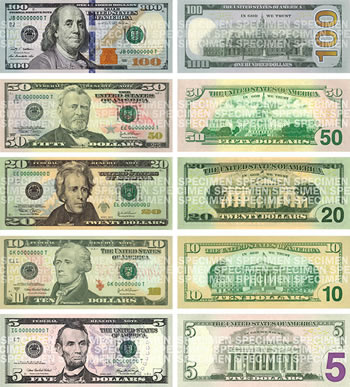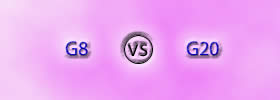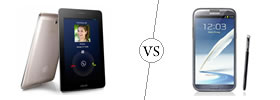Difference between Euro and Dollar
Key difference: The Euro is the official currency of the Eurozone. It is also the currency used by the Institutions of the European Union. The US Dollar, on the other hand, is the official currency of the United States and its overseas territories. It is also the most commonly used currency for international transactions. Furthermore, it is one of the world's most dominant reserve currencies. While, the Euro is considered to be the second largest reserve currency and the second most traded currency.
 The Euro and the Dollar are two different currencies that are in use in the world today. While the Euro is the official currency of the eurozone, the dollar is a bit more complicated than that. There are in fact many currencies in the world termed as dollars. The dollar is used by Australia, Belize, Brunei, Canada, Hong Kong, Namibia, New Zealand, Singapore, Taiwan, the United States, and previously Zimbabwe. Their currencies are termed as the Australian dollar, Canadian dollar, Hong Kong dollar, U.S. Dollar, etc. in order to be differentiated from each other. The most prominent and commonly used currency of these is the U.S. Dollar. Hence, let’s compare Euro to the US Dollar.
The Euro and the Dollar are two different currencies that are in use in the world today. While the Euro is the official currency of the eurozone, the dollar is a bit more complicated than that. There are in fact many currencies in the world termed as dollars. The dollar is used by Australia, Belize, Brunei, Canada, Hong Kong, Namibia, New Zealand, Singapore, Taiwan, the United States, and previously Zimbabwe. Their currencies are termed as the Australian dollar, Canadian dollar, Hong Kong dollar, U.S. Dollar, etc. in order to be differentiated from each other. The most prominent and commonly used currency of these is the U.S. Dollar. Hence, let’s compare Euro to the US Dollar.
The Euro is the official currency of the eurozone. It is also the currency used by the Institutions of the European Union, such as the European Parliament, the European Council, the Council of the European Union, the European Commission, the Court of Justice of the European Union, the European Central Bank and the Court of Auditors.
The Eurozone, which uses the Euro as its official currency, consists of 18 of the 28 member states of the European Union, including Austria, Belgium, Cyprus, Estonia, Finland, France, Germany, Greece, Ireland, Italy, Latvia, Luxembourg, Malta, the Netherlands, Portugal, Slovakia, Slovenia, and Spain.
The US Dollar, on the other hand, is the official currency of the United States and its overseas territories. It is also the most commonly used currency for international transactions. Furthermore, it is one of the world's most dominant reserve currencies. Many countries, other than the US, use the currency as their official currency, while many others use it as the de facto currency, which means that while it is not the legal tender in the country, it is still used as such by the citizens.
 In the world today, the US Dollar is considered to largest reserve currency and the most traded currency, while the Euro is considered to be the second largest reserve currency and the second most traded currency. However, in November 2013, the Euro surpassed the U.S. dollar by having the highest combined value of banknotes and coins in circulation, which amounted to more than €951 billion.
In the world today, the US Dollar is considered to largest reserve currency and the most traded currency, while the Euro is considered to be the second largest reserve currency and the second most traded currency. However, in November 2013, the Euro surpassed the U.S. dollar by having the highest combined value of banknotes and coins in circulation, which amounted to more than €951 billion.
The Euro is fairly new as compared to the US dollar, or rather most of the currency today. The Euro was officially adopted on 16 December 1995, and was introduced to world financial markets as an accounting currency on 1 January 1999. However, the Euro coins and banknotes did not enter into circulation until 1 January 2002. Whereas, the US Dollar dates back to August 8, 1786, when the Continental Congress of the United States authorized the issuance of the US dollar.
Both the euro and the dollar are subdivided into 100 cents to a Euro or a dollar. However, the denominations in which they are represented differ. The Euro has coins in denominations of 1c, 2c, 5c, 10c, 20c, 50c, €1, €2, whereas the UD Dollar is represented in denominations of 1¢, 5¢, 10¢, 25¢, 50¢, $1.
Still, the most prominent while comparing the two currencies is their value. While, the actual rate of conversion differs depending on the financial markets of the world, ever since its introduction, the rate of euro has always been more than the rate of the US dollar. However, whether it will continue to do so will be decided by the world financial market.
Furthermore, there are such things called Eurodollars, which are time deposits made in U.S. dollars at banks outside the United States. As they are outside of the US, they are not under the jurisdiction of the Federal Reserve. Hence, they are under less regulation and can result in higher margins. This however actually does not have any connection with the euro as a currency or the eurozone.
Comparison between Euro and Dollar:
|
|
Euro |
United States Dollar |
|
Definition |
The euro is the currency used by the Institutions of the European Union and is the official currency of the eurozone, |
The United States dollar is the official currency of the United States and its overseas territories. |
|
Introduced |
16 December 1995 |
August 8, 1786 |
|
ISO 4217 code |
EUR (num. 978) |
USD (num. 840) |
|
Central bank |
European Central Bank |
Federal Reserve System |
|
Symbol |
€ |
$ |
|
Nickname |
|
Buck, bill, bean, paper, smackeroo, ducat, doubloon, dead president, smacker, and greenback. Plural: dough, green, bread, bones, simoleons, bananas, skrilla, (bank) clams, mint sauce Also, Washingtons, Jeffersons, Lincolns, Jacksons, Benjamins, Grants, and Hamiltons are used based on denomination; also peso in Puerto Rico, and piastre in Cajun Louisiana. |
|
Subunit |
1/100 – Cent |
1/10 – Dime 1/100 – Cent 1/1000 – Mill |
|
Coins |
1c, 2c, 5c, 10c, 20c, 50c, €1, €2 |
1¢, 5¢, 10¢, 25¢, 50¢, $1 |
|
Notes |
€5, €10, €20, €50, €100, €200, €500 |
$1, $2, $5, $10, $20, $50, $100 |
|
Pegged by |
9 currencies
|
23 currencies
|
|
Users |
18 countries of the Eurozone
9 countries outside the Eurozone
3 other countries unofficially
|
Official Users
U.S. territories
Unofficial users
6 non-U.S. territories
|
Image Courtesy: theguardian.com, thedonutproject.com









Add new comment